Jennifer Wheeler shares “postcards” from her recent volunteer vacation in the Bahamas, where she sailed the ocean blue with a crew of dedicated conservationists. She shares stories from a week spent in the beautiful northern Exumas, surveying and banding shorebirds and seabirds, and removing invasive plants.
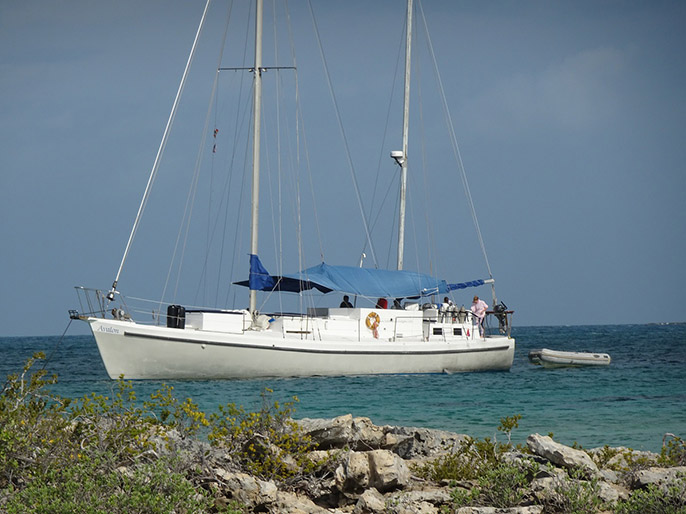
Dear folks,
I’m recently back from my “volunteer vacation” in the Bahamas. I’m a bit burned, battered and bruised, but that’s the nature of the work we were doing to find and protect some special birds! Similar to last year, Conservian, a non-profit in Florida, invited BirdsCaribbean to share in the chartering of a sleep-aboard sailboat to take us from island to island. This photo was taken on a sunny afternoon, but much of the trip was overcast … too bad clouds don’t keep you from getting sunburned! (Photo by Dawn Rasmussen)
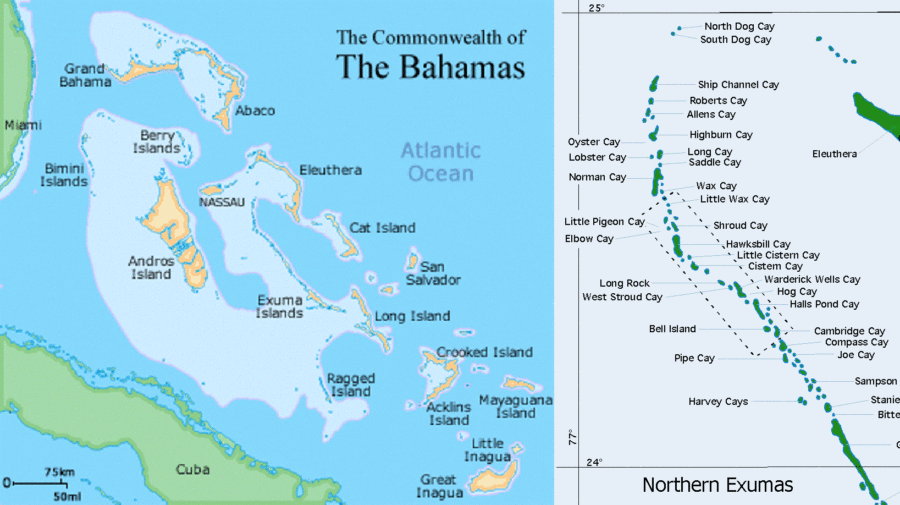
As you know, the Bahamas is made up of a lot of islands (about 700!) and during my week on the boat, the route focused on the Exuma Cays, which begin about 35 miles east-southeast of Nassau and stretch southeast in a gently curving arc for about 90 miles. Over a week, we visited the stretch between Allen Cay and Warderick Wells cay, which includes the Exuma Cays Land and Sea Park.
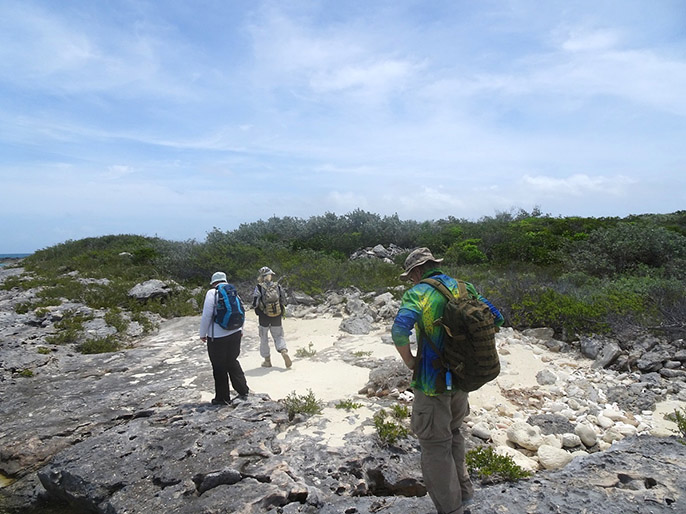
So what were we looking for? Our primary targets were breeding populations of Wilson’s Plover, White-tailed Tropicbird and Audubon’s Shearwater. We deployed in teams to various cays to search the beaches and cliffs, walking many hours during the day (and sometimes night). We took note of other birds, as well, including American Oystercatchers, Laughing Gulls, and Least Terns. (Photo by Dawn Rasmussen)
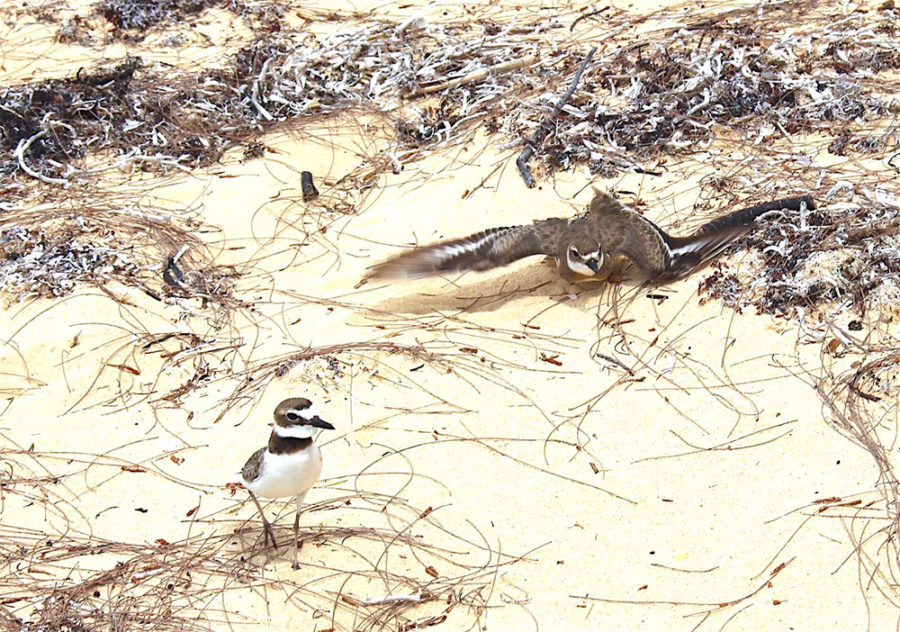
Wilson’s Plover is a medium size (about 8” tall) shorebird that forages on the sand and wrack; pairs of plovers set up breeding territories widely separated along beach habitats. To find Wilson’s Plover, teams visited cays with suitable habitat and carefully walked the beach looking for adult birds to call out in warning. One or two adults chirping and/or pretending injury was a good sign that a nest was nearby. (Photo Bella Rooney)
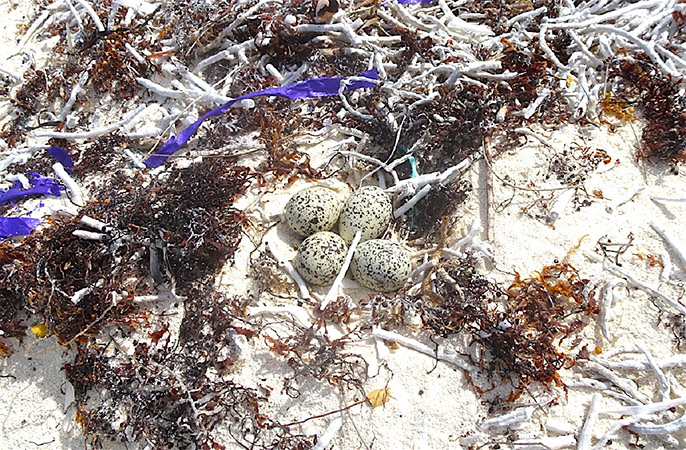
Actually finding the plovers’ simple nest is not easy. The spotted eggs blend perfectly into their surroundings. Careful where you walk! (Photo by Dawn Rasmussen)
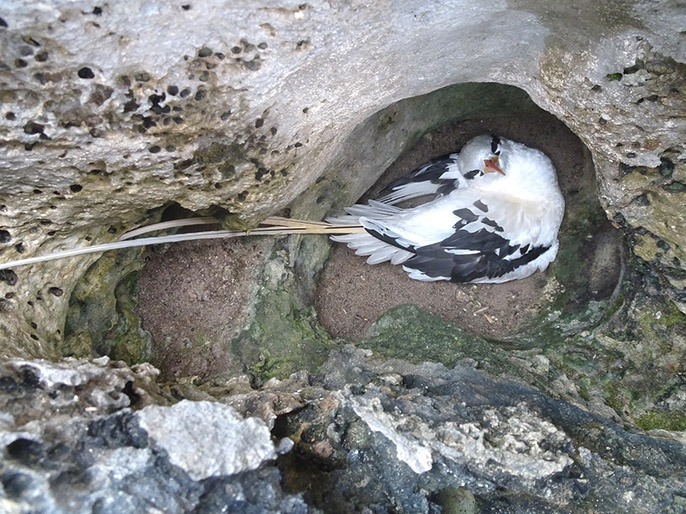
The White-tailed Tropicbird is a striking white bird, 14-16” long, not counting its long streaming tail feathers. To find these birds, one must do a lot of stooping and peering, as these beautiful birds nest in the holes and crevices formed in the wind and wave-carved limestone made of ancient corals (very, very sharp, by the way). We found most tropicbirds on a single egg or new chick; the males and females take turns in the burrow, waiting on average nine days until their turn to fly far out to sea to forage for squid, flying fish, and other prey. (Photo by Dawn Rasmussen)
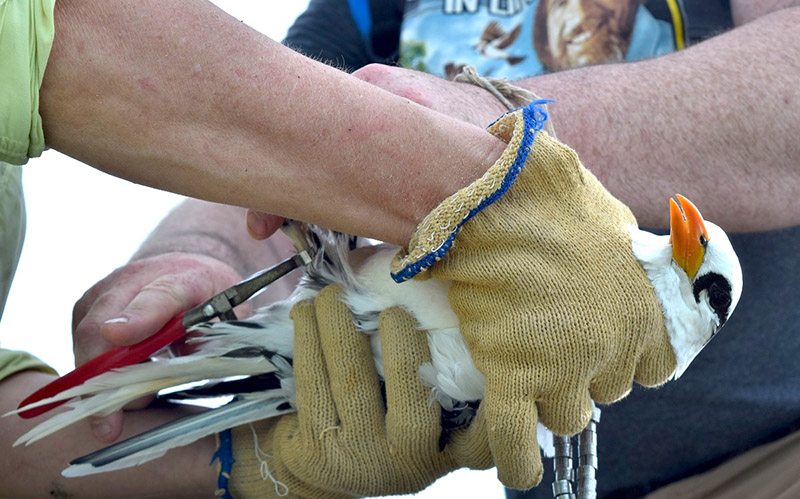
In all, we found about 150 tropicbird nests on three different islands in the Exuma Cays Land and Sea Park. We banded 60 new birds and recaptured more than 10 that were banded in previous years. Though graceful in the air, in the hand these birds are fighters. The White-tailed Tropicbirds were none too pleased to be pulled from their nest holes and each came out screaming and biting. We took care to minimize the stress on the birds when handling and worked quickly to band them. (Photo by Lisa Ferguson)
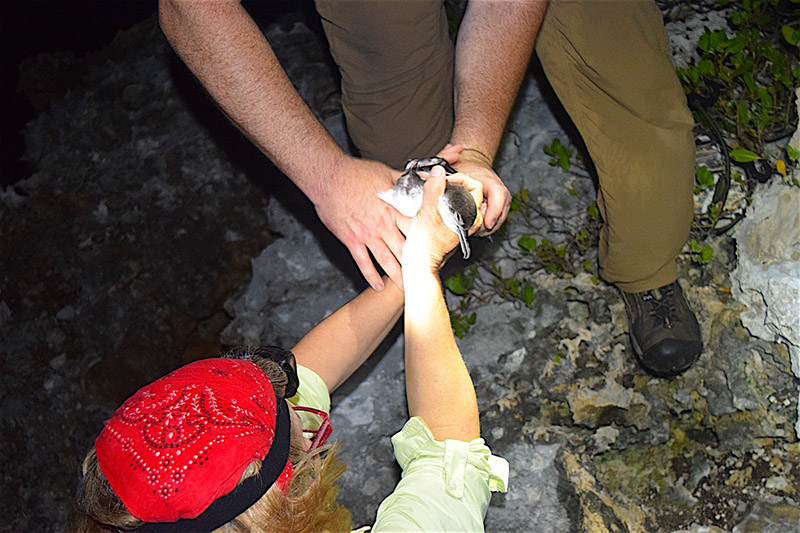
Audubon’s Shearwater is another bird of the open ocean, which returns to land only in darkness and nests in natural cavities, under rocks, or in burrows it creates; it is a stocky, black and white bird, 12” from bill to tail. Surveying for shearwaters requires working at night. Being smaller, drabber, and more deeply tucked in than tropicbirds, shearwaters usually can’t be seen from the surface. Instead, a recording of courtship calls (or rather, screeches- listen below!) is played to prompt the birds to call out, sometimes from right beneath your feet. (Photo by Lisa Ferguson)
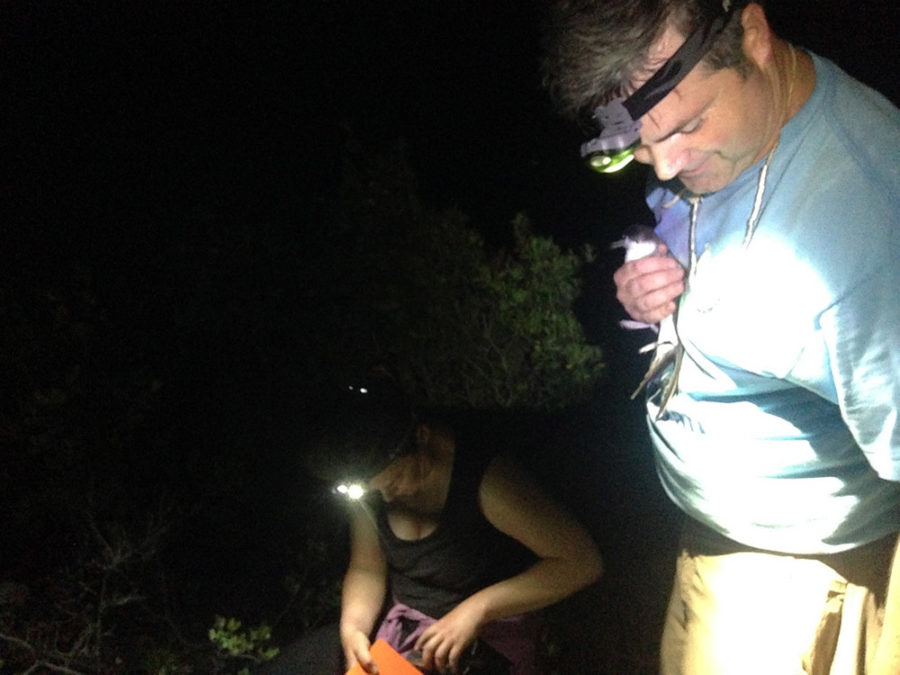
With a sleeping mat to cushion against sharp rock and vegetation, one can reach in to pull out struggling shearwaters, which fortunately are not able to bite nearly as hard as tropicbirds. We banded several, but it seemed as if shearwaters were taking a year off from breeding, something that is not uncommon when spring weather is bad (as it was this year). The good news is that the rodent traps that we set out for a week on Allen Cay yielded no mice! It would appear that the mouse eradication conducted in 2012 was successful. Mice did not directly harm the Audubon’s Shearwaters there, but their presence encouraged Barn Owls to settle on the island, which indiscriminately killed shearwaters. Also, a careful survey in daylight hours revealed very few fresh bird corpses – yay! (Photo by Jennifer Wheeler)
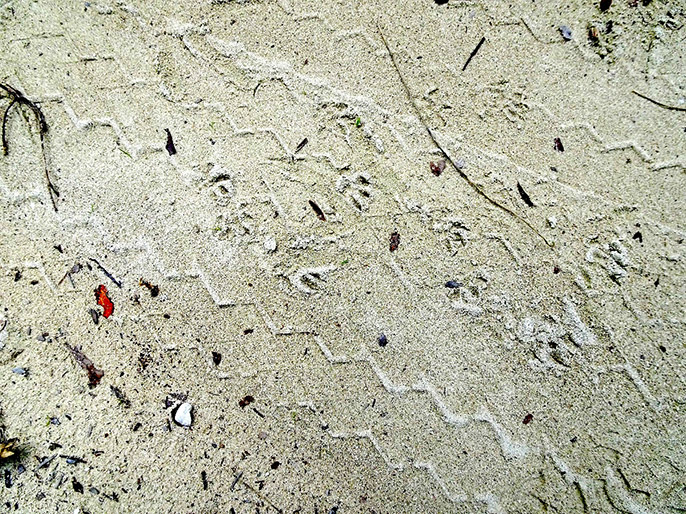
Keeping an eye on bird populations is important to conservation, but our project also involved taking action to help the birds. Caribbean bird populations today are just a remnant of the masses that once called the region home – historically reduced by human harvest, introduction of predators, and development and conversion of habitat to human uses. The small, uninhabitable cays and those in the Park are protected from development, but still threatened by alien species, and some cays are inhabited. In addition to bird sightings, teams recorded the state of the habitat and signs of threats, such as tire prints and footprints indicating human disturbance or predators. (Photo by Dawn Rasmussen)
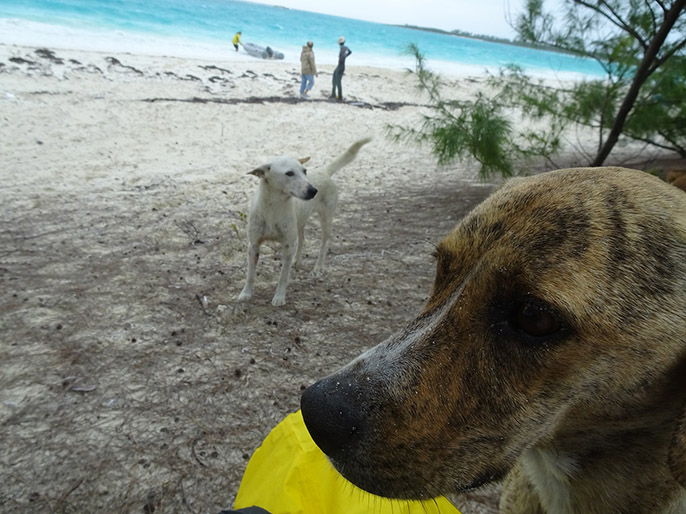
Introduced mammals are a big problem for island birds. The Warderick Wells tropicbird colony is still recovering from its decimation by dogs several years ago. On this trip, we encountered dogs on Shroud Cay. They were very friendly, and you know I love dogs, but it was definitely not good to see them there! Dogs running free pose a threat to the birds, not to mention iguanas, hutias (native rodents), and other native species. (Photo by Dawn Rasmussen)
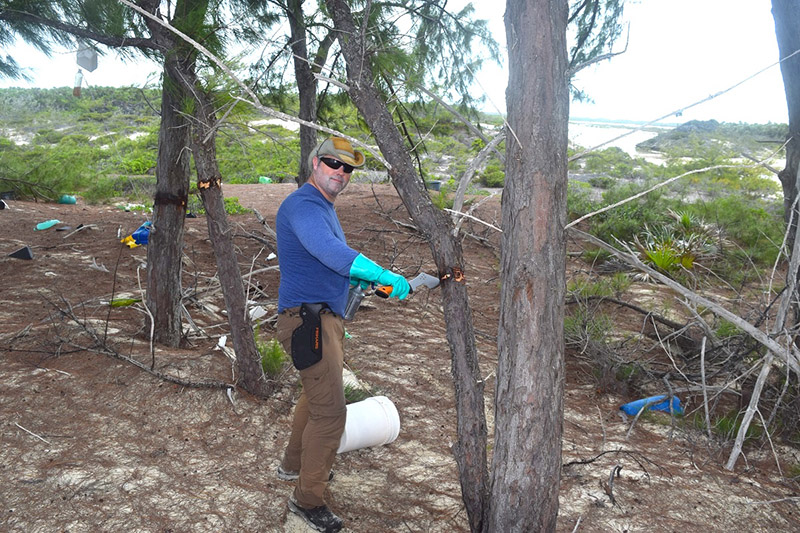
Introduced plants can also be a big problem. A prime example is Casuarina, or Australian Pine (Casuarina equisetifolia). The plant was originally brought to the region for landscaping and is now a scourge. Its fast growth and prolific seeding has distributed it to almost every island in the Bahamas, where its thick litter smothers native vegetation and increases beach erosion. We spent a full day killing casuarina on Shroud Cay, using axes to hack girdles and spraying an herbicide into the cuts. The “hack and squirt” method is quite effective, but hundreds of trees in, gets very tiring. Plus, the necessary gloves, glasses, long sleeves and pants makes for very hot work! (Photo by Lisa Ferguson)
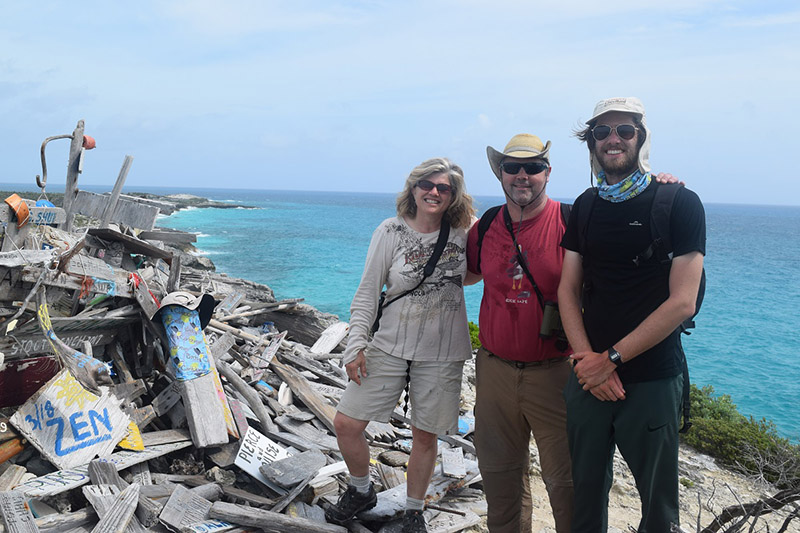
All and all a great trip for me – the birds were awesome, my team members were great, the sailboat crew superb, the weather decent and no sea-sickness! It felt good to contribute to our knowledge of Bahamas birdlife and conservation efforts. I’m grateful to Margo Zdravkovic, Director of Conservian, for organizing the trip, Will Mackin, Co-chair of BirdsCaribbean’s Seabird Working Group, for leading the seabird monitoring work, the many volunteers who assisted with the work, and the fantastic captain and crew of the sailboat Avalon (charter them at Lost Island Voyages)! (Photo by Lisa Ferguson)
Love,
Jennifer
Jennifer Wheeler is an avid adventurer and loves volunteering her time to help conservation causes. She was the coordinator of the Waterbird Council for 10 years and is currently a member of the Board and Treasurer of BirdsCaribbean.
This trip was supported by BirdsCaribbean, Conservian, and many partners and donors. For more information about multi-week excursions that Conservian organizes to the Bahamas and the trip sponsors and partners, see the full trip description and visit Conservian’s Facebook page

Great write-up! You did a fantastic job of capturing the essence of it. Thank you!!